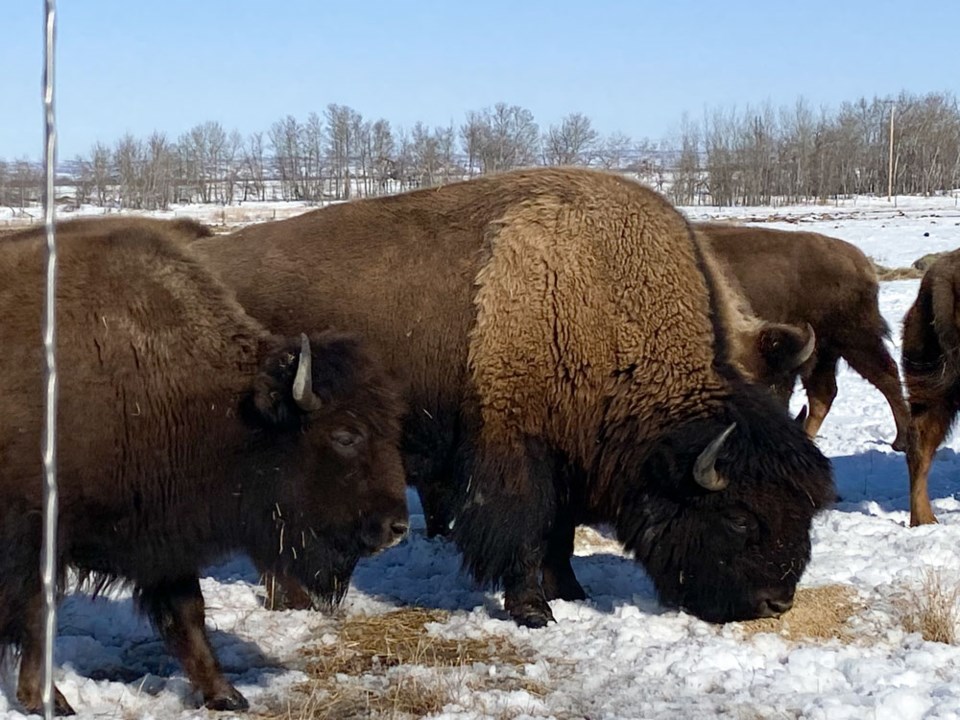STOUGHTON - When driving down the gravel road just northeast of Stoughton, you will pass Dwight Shiels and Tanya Dubois’ ranch.
You may think they are regular beef ranchers, but if you look closely, you may get a glimpse of their bison herd.
At one time the bison was almost eliminated from existence, but through passionate conservationists and knowledgeable ranchers, their numbers continue to increase, and the herds are healthier. Big D Bison is one of them.
The woods and plains bison are native to North America. They are the largest land mammal here, with the bulls easily reaching 2,000 pounds. The two species are quite different, if you know what to look for. Woods bison have a large triangle head, their shoulders are more pointed, along with their hair and cape being less defined. They are also much more aggressive of the two breeds.
Plains bison have a massive head, a shorter nose and their shoulders are rounder. Their cape and hair are more defined and shaggier. Big D Bison has a herd of plains bison.
Bison are intelligent animals that are extraordinarily strong and agile. They usually are not dangerous unless they feel threatened, which can change their mood quickly. Bison also have poor vision.
The large beast is meant for Saskatchewan winters with their thick insulated coats. They are well protected from the climate and in the chilly winter months their metabolism slows down.
Shiels and Dubois became intrigued several years ago when they traveled to the United States and came across a museum in Oakley, Kans., which was all about the bison. They soon began their research on the breed and now have a herd of 40 plains bison.
Dwight has both cattle and bison, but admits the bison are easier in many ways. According to Shiels, the bison cows become mature at the age of two and then are ready for breeding, with a nine-month pregnancy and calving usually occurring in April and May.
They have three bulls, Hank, who is the largest and the oldest, Rocky and Lucky. Shiels said they need several bulls, or they do not feel the need to breed in a timely manner. Having competition in the herd encourages the bulls to keep active and get the job done.
The bison cows do not need help with calving, Dubois said, unlike with beef one needs to do regular checks during calving season, as with bison it is all done on their own. It is extremely rare for a bison cow to have twins as they have half the milk production of a beef cow. So, twins in bison would usually not make it.
When calving is completed, they will wean in December or January. This is the most challenging time for the bison as they do not like enclosed areas and it causes the herd stress. Just recently, Shiels and Dubois went to a convention in Yorkton to learn more about stress free handling. They are always wanting to learn more and are members of the Canadian Bison Association. After weaning, the animals are raised till 24 to 30 months. While the bulls go for meat, the young females remain to increase the herd.
Bison eat half as much as a beef cow. They are free range and raised on grass in the summer. Winter months they are given hay and pellets for a treat. Shiels said herds are much healthier today and they only need salt and minerals added to their diet. They have a great deal of respect for the fencing and very rarely get out.
Â鶹´«Ã½AVeast Butcher Block out of Alameda is in the works of purchasing Davis Meats. It is their plan to build new with expanding to 2 1/2 times the size. At present shares are being sold to make it a co-operative.
Justin Marcotte stated that it will be a profitable venture with a five to seven per cent return for the investors. The new building for the abattoir is hoped to be completed in the fall of 2022 or spring of 2023. This will all depend on shares sold.
The new place will continue to have custom processing for producers and will house a retail store selling bison, beef, lamb and pork. Murray from Davis Meats will become the new manager.
Big D Bison has purchased shares in the hopes their bison meat will be sold there. Marcotte stated that only top-quality meat will be selected for the retail store, but right now they are continuing to look for shareholders.
During the tour of the ranch, as Dubois proceeded to get pellets and spread them on the ground, the herd came running. One needs to have respect for these incredible creatures, as when one starts running, they all start, mainly because of their poor eyesight. The ground rumbled at their approach. These massive beasts have respect for vehicles.
Dubois stated she just loves the bison and cannot wait for the little orange babies to be running around. If you wish to learn more about these creatures or to follow the ranch, they can be found on Facebook under Big D Bison, where updates are posted on a regular basis.





